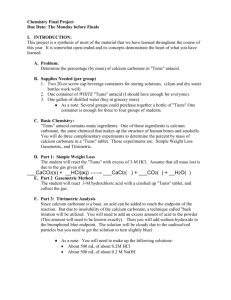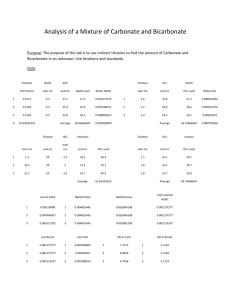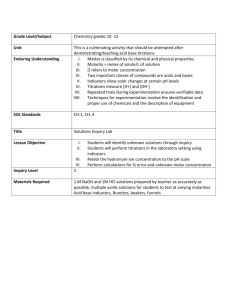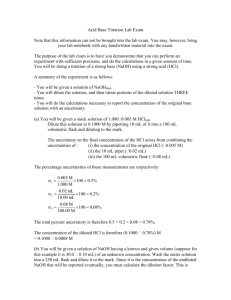Experiment #11: Titration of a Commercial Antacid
advertisement
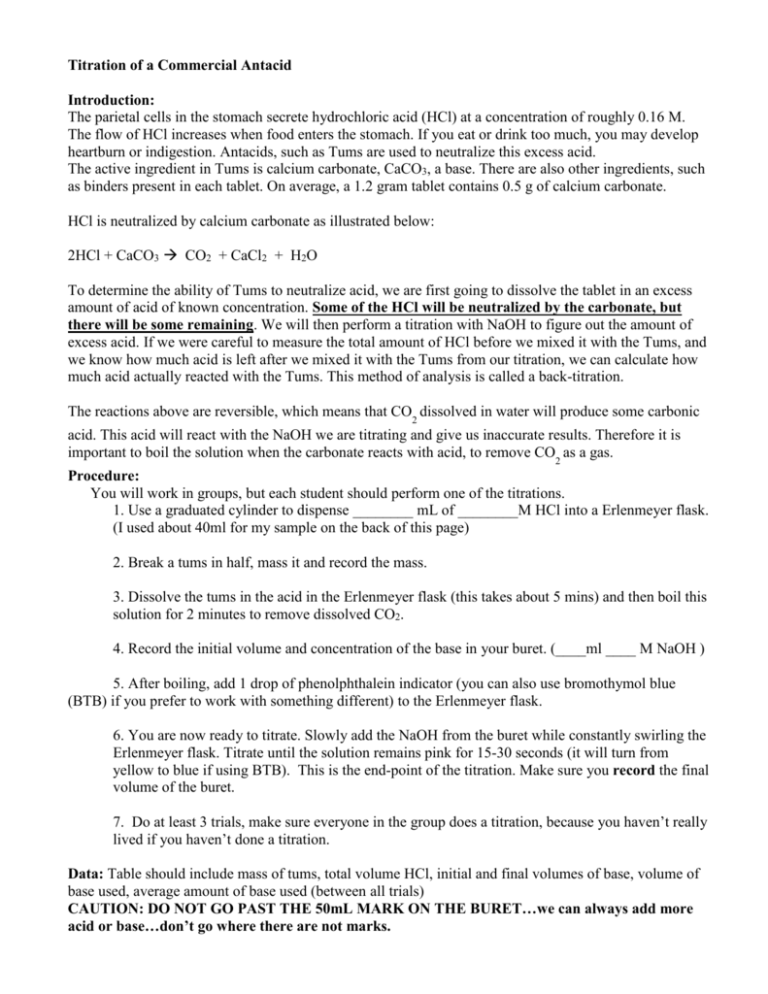
Titration of a Commercial Antacid Introduction: The parietal cells in the stomach secrete hydrochloric acid (HCl) at a concentration of roughly 0.16 M. The flow of HCl increases when food enters the stomach. If you eat or drink too much, you may develop heartburn or indigestion. Antacids, such as Tums are used to neutralize this excess acid. The active ingredient in Tums is calcium carbonate, CaCO3, a base. There are also other ingredients, such as binders present in each tablet. On average, a 1.2 gram tablet contains 0.5 g of calcium carbonate. HCl is neutralized by calcium carbonate as illustrated below: 2HCl + CaCO3 CO2 + CaCl2 + H2O To determine the ability of Tums to neutralize acid, we are first going to dissolve the tablet in an excess amount of acid of known concentration. Some of the HCl will be neutralized by the carbonate, but there will be some remaining. We will then perform a titration with NaOH to figure out the amount of excess acid. If we were careful to measure the total amount of HCl before we mixed it with the Tums, and we know how much acid is left after we mixed it with the Tums from our titration, we can calculate how much acid actually reacted with the Tums. This method of analysis is called a back-titration. The reactions above are reversible, which means that CO2 dissolved in water will produce some carbonic acid. This acid will react with the NaOH we are titrating and give us inaccurate results. Therefore it is important to boil the solution when the carbonate reacts with acid, to remove CO2 as a gas. Procedure: You will work in groups, but each student should perform one of the titrations. 1. Use a graduated cylinder to dispense ________ mL of ________M HCl into a Erlenmeyer flask. (I used about 40ml for my sample on the back of this page) 2. Break a tums in half, mass it and record the mass. 3. Dissolve the tums in the acid in the Erlenmeyer flask (this takes about 5 mins) and then boil this solution for 2 minutes to remove dissolved CO2. 4. Record the initial volume and concentration of the base in your buret. (____ml ____ M NaOH ) 5. After boiling, add 1 drop of phenolphthalein indicator (you can also use bromothymol blue (BTB) if you prefer to work with something different) to the Erlenmeyer flask. 6. You are now ready to titrate. Slowly add the NaOH from the buret while constantly swirling the Erlenmeyer flask. Titrate until the solution remains pink for 15-30 seconds (it will turn from yellow to blue if using BTB). This is the end-point of the titration. Make sure you record the final volume of the buret. 7. Do at least 3 trials, make sure everyone in the group does a titration, because you haven’t really lived if you haven’t done a titration. Data: Table should include mass of tums, total volume HCl, initial and final volumes of base, volume of base used, average amount of base used (between all trials) CAUTION: DO NOT GO PAST THE 50mL MARK ON THE BURET…we can always add more acid or base…don’t go where there are not marks. Sample data with Calculations Trial 1 Mass of tums = 0.51g Starting volume of 0.2M HCl= 0.0ml Ending volume of 0.2M HCl = 39.9 ml Volume of 0.2M HCl used = 39.9ml Starting volume of 0.1M NaOH= 3.5ml Ending volume of 0.1M NaOH= 42.4ml Volume of 0.02M NaOH used= 38.9ml We now use the equation MaVa = MbVb to determine the volume of the HCl that was left after reacting with the tums. 0.2M HCl ( X) = 0.1M NaOH (38.9ml) X= 19.45 ml of remaining 0.2M HCl But we put 39.9ml of HCl into the flask…and 19.45ml remained after the reaction. Can we determine how many ml of 0.2M HCl reacted with our tums? Yes…subtract the remaining volume (found from the titration) from the total volume. 39.9ml- 19.45ml= 20.45 ml of 0.2M HCl was needed to react with the piece of tums completely. Woot! Woot! We found the answer!...nope. Ahh Snap! Remember, we want to know how much CaCO3 was in the tums…the amt of HCl used in the reaction with the tums can tell us how much CaCO3 was in the tums. Remember this equation? Molarity = moles/L We know the Molarity of the HCl used…and we know the volume. If we rearrange the equation… Molarity x Liters = moles………..(Don’t for get to convert your volume to liters) 0.2M x (.02045L) = .00409 mols of HCl used in the reaction Now if we look at the balanced chemical reaction that has been on the board for the last 3 days…we see that for every 2 mols of HCl reacted…1 mol CaCO3 is reacted. So… .00409 mols of HCl (1mol CaCO3 / 2 mol HCl) = .002045 mol of CaCO3 was in our piece of tums You should be able to convert from moles of CaCO3 to grams of CaCO3….and then determine the percent of CaCO3 per mass of tums. (This is the same thing you have been doing for the past 2 days) Using this data…I got 39.3%

